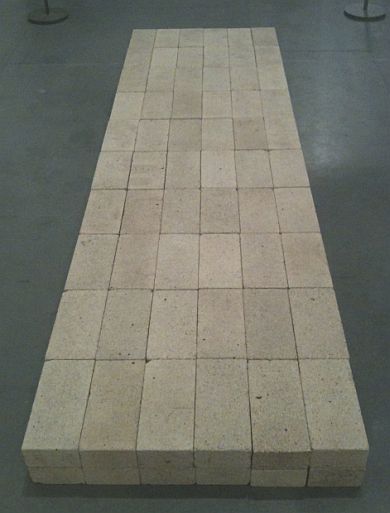|
 Equivalent VIII aka
"The Bricks"
- 120 fire
bricks
Equivalent VIII aka
"The Bricks"
- 120 fire
bricks
by Carl André, 1966
purchased by the Tate Modern Gallery in 1972 for $10,000.00
|
|
The Tate isn't an
art gallery:
it's a collection of
art galleries.
To fully appreciate the works in just one of them, the
Tate Modern for example, could take days. When I arrived at the
Tate Modern for a pre‑allocated three hour visit, Equivalent
VIII was far from my mind. I'd actually forgotten about it.
Walking around the Tate's halls ie its
galleries
within its
gallery
- some of them the size of cozy city
art
outlets, some of them massive enough to house three or four
commuter sized aircraft - I was struck by how the Tate is more than
a home for
art:
it's its
context.
The Tate itself is as much an
art
medium, as
canvas
and oil
paint
and pedestals are, on which its huge range of work is
created
and showcased.
So it was almost by accident as I, approaching my time to leave,
and having viewed way too many
extraordinary
pieces in way too short a period of time to appreciate them all and
do them all justice, turned a corner and caught a glimpse of
something which resulted in (this is the truth) these words
spontaneously entering my mind: "What on Earth is
that? It looks like a pile ... of ...
bricks
...". Then, suddenly shocked, I realized I'd stumbled on,
completely by accident, Carl André's Equivalent VIII. In
another moment I'd have obliviously exited the building and would
have missed the piece entirely.
This is what I got: yes it is a pile of
bricks,
and yes it's a work of
art.
And here's the thing: you get to choose which it is -
that is, you get to say what it is ... because the
very, very first thing to get about appreciating
art
is there's nothing to appreciate in
art
except for the appreciation you ascribe to it.
I assert there's no intrinsic value at all in
Equivalent VIII, just as there's no intrinsic value at all in Pablo
Picasso's Nude, Green Leaves and Bust aka "Nude with
Sculptor's Turntable", also on display at the Tate, even with (get
this) its staggering $106,500,000.00 price tag. And just as "It's
money wasted on a pile of
bricks"
is said about Equivalent VIII, so could "It's an assault on common
sense" just as easily be said about Nude, Green Leaves and Bust.
But
art
only starts being interesting when you look at it from
the
viewpoint
of
creating
its value rather than from the
viewpoint
of looking at its value.
We're all too often convinced
art
has value. But we're also convinced of many other obvious things
which, after inquiry, are revealed to be simply open to
interpretation.
For example, we're convinced there's an "I" which is real, for each
of us. There isn't. This "I" isn't real. It's just something that
shows up
for each of us. It's an entirely new world which opens up ie it's
an entirely new possibility for being which opens up
when we start seeing our "I" not as
who we really
are
but rather as something which
shows up up for us -
just as it's an entirely new world which opens up ie it's an
entirely new possibility for being which opens up when we start
seeing the value in
art
as something we ascribe to
art,
rather than as something already in
art
for us to evaluate.
|


